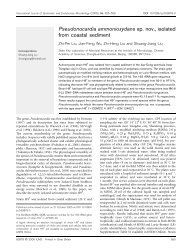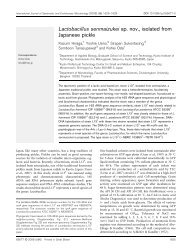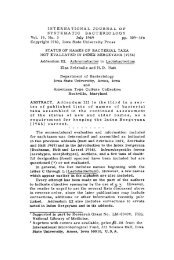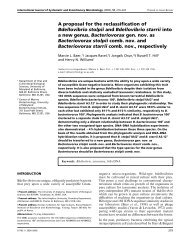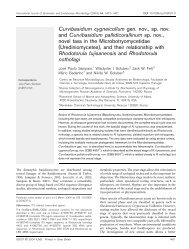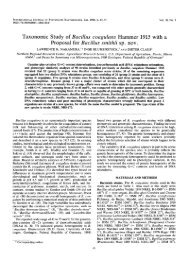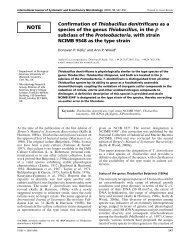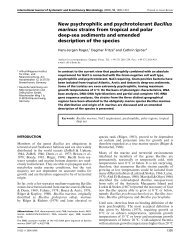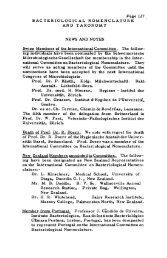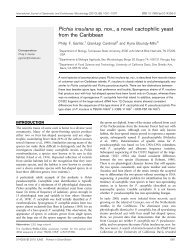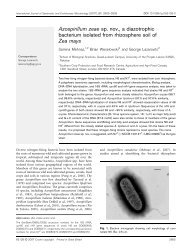Designation of type strains for seven species of the order ...
Designation of type strains for seven species of the order ...
Designation of type strains for seven species of the order ...
You also want an ePaper? Increase the reach of your titles
YUMPU automatically turns print PDFs into web optimized ePapers that Google loves.
(Neo-)Type <strong>strains</strong> <strong>for</strong> <strong>species</strong> <strong>of</strong> myxobacteria<br />
(a)<br />
11<br />
12<br />
7 8<br />
10 9<br />
13<br />
(b)<br />
Fig. 4. Chondromyces pediculatus. (a) Drawing from Thaxter (1904),<br />
plate XXVI on page 411; nos 7–13 depict Chondromyces<br />
pediculatus. (b) Fruiting body <strong>of</strong> Cm p51 T .Bar100mm.<br />
(Skerman et al., 1980). According to a curator <strong>of</strong> <strong>the</strong><br />
herbarium, <strong>the</strong> specimen <strong>for</strong> Chondromyces lanuginosus<br />
seems to be lost whereas <strong>the</strong> o<strong>the</strong>r three specimens are still<br />
<strong>the</strong>re, dried on <strong>the</strong> original substrates, accompanied by some<br />
slides.<br />
For <strong>the</strong> <strong>species</strong> Melittangium boletus (Jahn, 1924), Polyangium<br />
sorediatum (Brockman, 1989a) and Polyangium spumosum<br />
(Brockman, 1989a) no physical <strong>type</strong> <strong>strains</strong> were assigned in<br />
<strong>the</strong> Approved Lists (Skerman et al., 1980) or in Validation List<br />
No. 31 (Brockman, 1989b,c), respectively. Instead, <strong>the</strong><br />
descriptions <strong>of</strong> Brockman (1989a) or simply <strong>the</strong> statement<br />
‘not cultivated’ are given.<br />
Bergey’s Manual <strong>of</strong> Systematic Bacteriology, second<br />
edition, includes comprehensive chapters about <strong>the</strong><br />
members <strong>of</strong> <strong>the</strong> <strong>order</strong> Myxococcales. Reichenbach (2005a,<br />
b, c, d, e) are <strong>the</strong> chapters relevant to <strong>the</strong> taxa mentioned in<br />
this paper. These chapters are based on <strong>the</strong> experience and<br />
knowledge accumulated during 40 years <strong>of</strong> intense<br />
investigations on myxobacteria and were written after<br />
more than 3000 myxobacterial <strong>strains</strong> had been isolated.<br />
Based on <strong>the</strong> original <strong>species</strong> descriptions, appropriate<br />
<strong>strains</strong> were selected and described as <strong>the</strong> <strong>type</strong> <strong>strains</strong> <strong>of</strong> <strong>the</strong><br />
respective <strong>species</strong> (Table 1). However, it has not been<br />
<strong>for</strong>mally proposed in <strong>the</strong> IJSEM until now to accept <strong>the</strong>se<br />
<strong>strains</strong> as <strong>the</strong> <strong>type</strong> <strong>strains</strong>.<br />
For <strong>the</strong> reason that presently dead preserved material<br />
constitutes-, or a description has been designated-, <strong>the</strong> <strong>type</strong><br />
strain <strong>of</strong> <strong>the</strong> mentioned <strong>species</strong>, or no <strong>type</strong> strain has been<br />
assigned, it is <strong>for</strong>mally proposed that <strong>the</strong> <strong>strains</strong> selected by<br />
Reichenbach shall be designated <strong>the</strong> <strong>type</strong> <strong>strains</strong> <strong>of</strong> <strong>the</strong><br />
respective <strong>species</strong> according to Rule 18f. The proposed <strong>type</strong><br />
<strong>strains</strong> listed in Table 1 shall replace <strong>the</strong> dead specimen or<br />
descriptions. These are Chondromyces apiculatus Cm a14 T ,<br />
Chondromyces crocatus Cm c5 T , Chondromyces lanuginosus<br />
Sy t2 T , Chondromyces pediculatus Cm p51 T , M. boletus Me<br />
b8 T , P. sorediatum Pl s12 T and P. spumosum Pl sm5 T . The<br />
prerequisite <strong>for</strong> <strong>the</strong> acceptance <strong>of</strong> <strong>type</strong> <strong>strains</strong>, <strong>the</strong>ir deposit<br />
and availability in two culture collections is achieved. The<br />
designation <strong>of</strong> <strong>the</strong> <strong>type</strong> <strong>strains</strong> is based on <strong>the</strong> descriptions<br />
given in <strong>the</strong> respective chapters <strong>of</strong> Bergey’s Manual<br />
(Reichenbach 2005a, c, d). In <strong>order</strong> to facilitate <strong>the</strong><br />
comparison <strong>of</strong> <strong>the</strong>se recent descriptions with those <strong>of</strong> <strong>the</strong><br />
authors who originally proposed, revived or emended <strong>the</strong><br />
<strong>species</strong> <strong>the</strong>se original descriptions are assembled in Table<br />
S1 available in IJSEM Online. The fatty acid composition <strong>of</strong><br />
<strong>the</strong> proposed <strong>type</strong> <strong>strains</strong> are given in Table S2 (Garcia<br />
et al., 2011). The figures from <strong>the</strong> original descriptions and<br />
<strong>of</strong> <strong>the</strong> proposed <strong>type</strong> <strong>strains</strong> are shown face to face with<br />
figures showing <strong>the</strong> proposed <strong>type</strong> <strong>strains</strong> in Figs 1–10.<br />
The Bacteriological Code also allows <strong>for</strong> <strong>the</strong> proposal <strong>of</strong><br />
neo<strong>type</strong> <strong>strains</strong> according to Rule 18c: ‘If a strain on which<br />
<strong>the</strong> original description was based cannot be found, a<br />
neo<strong>type</strong> strain may be proposed. A neo<strong>type</strong> strain must be<br />
proposed (proposed neo<strong>type</strong>) in <strong>the</strong> IJSB, toge<strong>the</strong>r with<br />
citation <strong>of</strong> <strong>the</strong> author(s) <strong>of</strong> <strong>the</strong> name, a description or<br />
(a) (b) (c)<br />
Fig. 5. Melittangium boletus. (a) Drawing from Jahn (1924), plate II, Fig. 17 on page 78. Courtesy Bornträger-Cramer,<br />
www.borntraeger-cramer.de. (b) and (c) Fruiting bodies <strong>of</strong> Me b8 T . Bars, 120 and 80 mm, respectively.<br />
http://ijs.sgmjournals.org 4357



